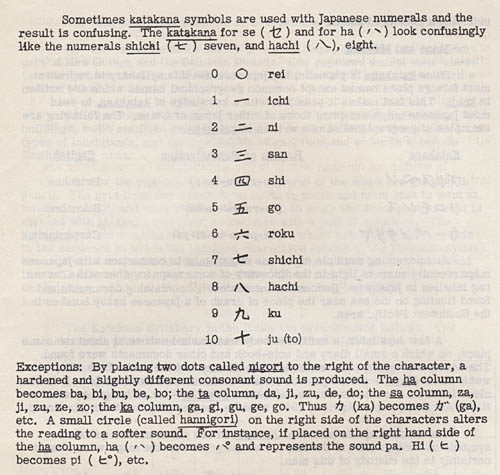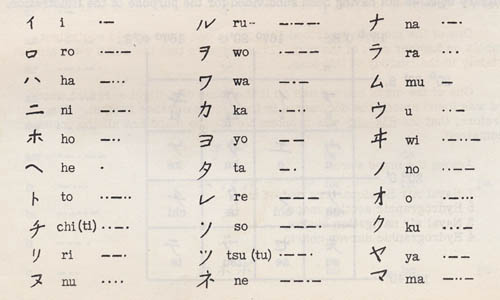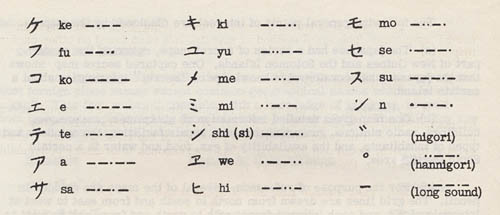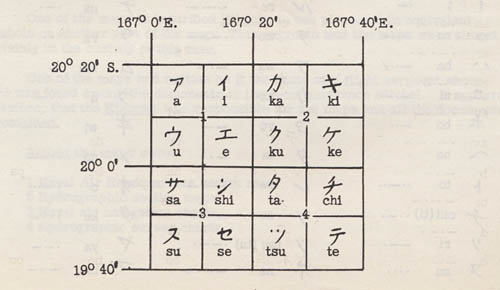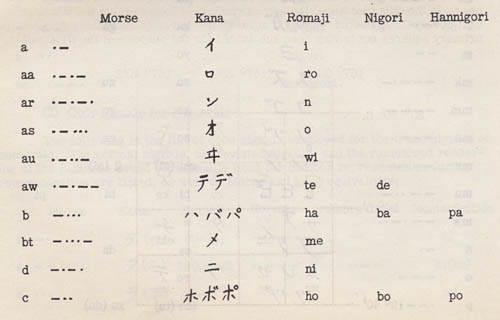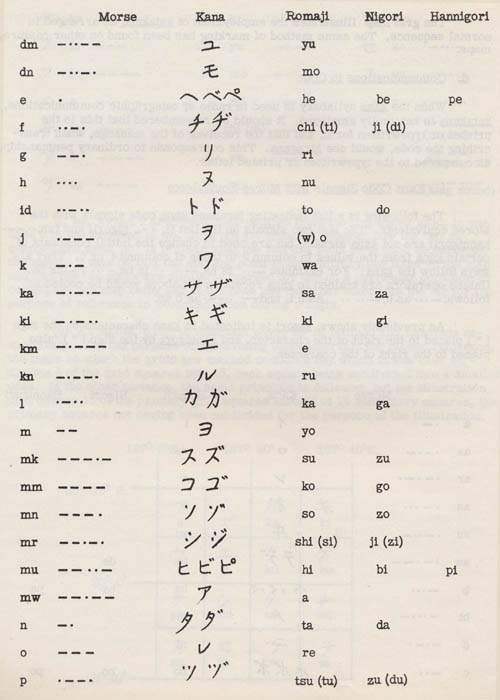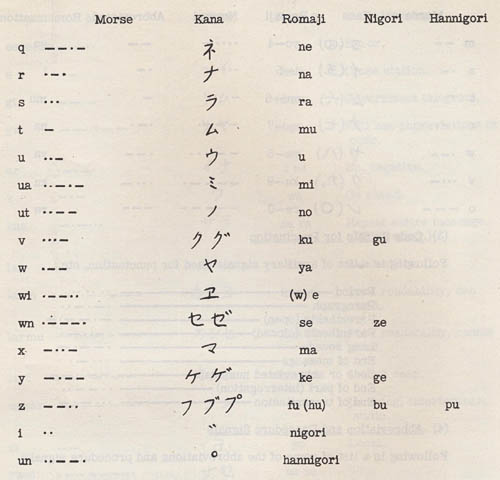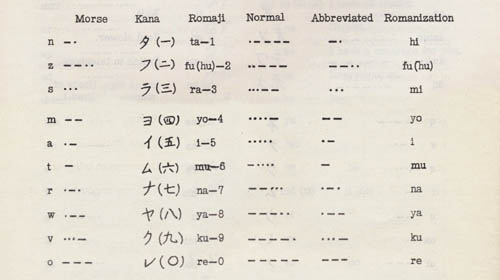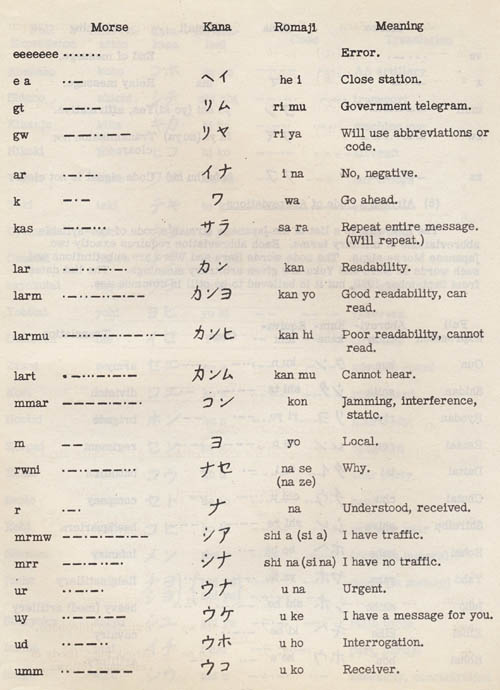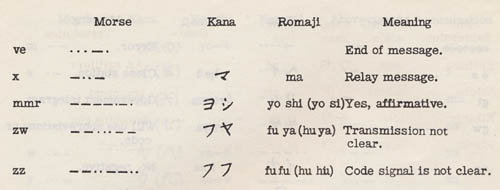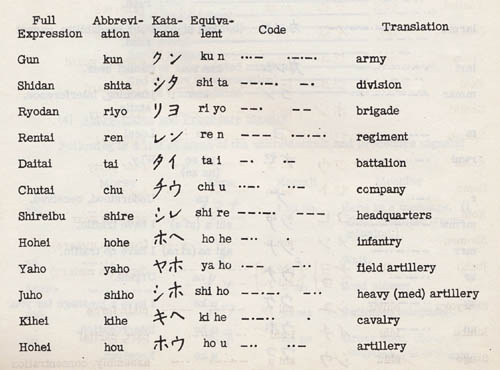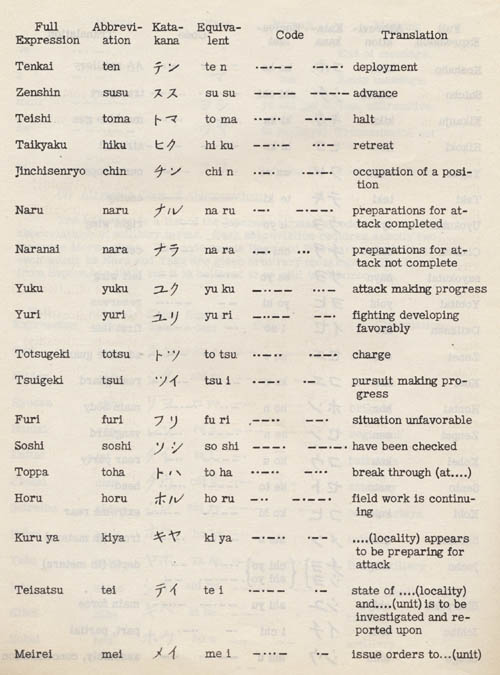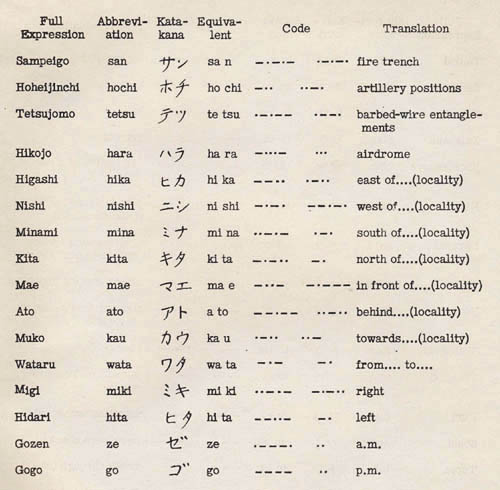![[Lone Sentry: Italian Measures for Concealing a Withdrawal, WWII Tactical and Technical Trends]](../../pics/sentry120x69.jpg)
![[Lone Sentry: Photographs, Documents and Research on World War II]](../../pics/lonesentrylogo.jpg)
|
The following article describing katakana, a Japanese phonetic syllabary, was printed for U.S. soldiers in
Tactical and Technical Trends,
No. 12, November 19, 1942.
[DISCLAIMER: The following text is taken from the U.S. War Department
publication Tactical and Technical Trends. As with all wartime
intelligence information, data may be incomplete or inaccurate. No
attempt has been made to update or correct the text. Any views or
opinions expressed do not necessarily represent those of the website.]
|
|
SOME EXAMPLES OF KATAKANA (PHONETIC JAPANESE) USED IN COMMUNICATIONS
This article is presented for the purpose of clarifying some of the mystery in which, to the layman, the Japanese language is shrouded. Also, it is to be hoped that it will stimulate some interest in the language, especially on the part of communications personnel. It must be pointed out that there exist no short cuts enabling one to acquire a comprehensive knowledge of this language. Years of unremitting labor are required to master even the fundamentals of writing Japanese kanji (the classic language, which is basically Chinese); however, kana, or phonetic Japanese writing, can be learned in a short time. Communications personnel may, with practice, intercept and transcribe some portions of coded messages which use kana. a. The Japanese Written Language (1) Chinese Characters (Kanji) It was not until the fourth or fifth century of the Christian era that the Japanese felt the need of putting down their thoughts in writing. They had no alphabet, and since their only intercourse with the then known world was with China to the west, they proceeded to borrow, along with many other things, their writing system from that country. The Chinese writing system is about as difficult a thing to learn or to use as man's mind has ever invented. It started out being a sort of picture language with each word represented by a simplified picture. This system was all right for words like "horse" or "fish," words that could be drawn, but it would not do for more abstract words like "duty," "courage," or "honesty." Obviously, the writing system had to develop far beyond simple pictures, which it did more than 3,000 years ago. But Chinese writing never lost some of its original pictorial quality. There still is one symbol, if not picture, for each word. As a result, there are thousands of symbols, or characters, as they are usually called, in use today in China. The Chinese system was not a handy one for the Japanese to borrow, but it was all they knew. They had to supplement it with other written signs (kana), developed by themselves, which showed sounds, the way our alphabet does, and not ideas, the way the Chinese characters do. But even after inventing these phonetic writing systems, they still kept to the Chinese characters. They were pronounced quite differently in Japan than in China, because the two spoken languages are not at all alike, but still they represented the same idea. Consequently, most Chinese words can be read and understood by Japanese, and many Japanese words can be read and understood by Chinese. This is not true for pronunciation. (2) Phonetic Characters (Kana: Katakana and Hiragana) In katakana and hiragana each character represents a sound, but, unlike English letters, each is made up of a consonant followed by a vowel, i.e., ka, ki, etc. Exceptions are the vowels a, e, i, o, u, and the consonant n. The katakana consists of 50 somewhat angular symbols which, apart from their use on aircraft, are used by the Japanese mainly for transcribing foreign sounds, and in notices, official documents, telegrams, ships' names, etc. Inscriptions in katakana are usually written from the right, either vertically or horizontally, but on occasions are written from left to right as in English. The hiragana syllabary compares with katakana as our script letters (a) compare with block printing (A). It also consists of 50 forms, but they are cursive in shape and are used in writing letters, in some newspapers, etc. These characters are seldom used for aircraft markings or for depicting ships' names. In writing out the kana sounds in our alphabet, the following rules are invariably used.
A table of the characters used in the katakana syllabary follows:
Sometimes katakana symbols are used with Japanese numerals and the result is confusing. The katakana for se (SYMBOL) and for ha (SYMBOL) look confusingly like the numerals shichi (SYMBOL) seven, and hachi (SYMBOL), eight.
Exceptions: By placing two dots called nigori to the right of the character, a hardened and slightly different consonant sound is produced. The ha column becomes ba, bi, bu, be, bo; the ta column, da, ji, zu, de, do; the sa column, za, ji, zu, ze, zo; the ka column, ga, gi, gu, ge, go. Thus SYMBOL (ka) becomes SYMBOL (ga), etc. A small circle (called hannigori) on the right side of the characters alters the reading to a softer sound. For instance, if placed on the right hand side of the ha column, ha (SYMBOL) becomes SYMBOL and represents the sound pa. Hi (SYMBOL) becomes pi (SYMBOL), etc. b. Application of Katakana to Aircraft As most Japanese aircraft are marked with characters from the katakana syllabary, it is essential that intelligence officers should have some knowledge of the characters used. In aircraft markings, the katakana syllabary is mainly used; therefore, should a float plane crash or be sighted bearing the under-mentioned markings -
upon referring to the katakana syllabary it would be observed that the first symbol represented the sound na, the second ga, and the third ra; the assembled syllables give "Nagara," the name of a Japanese cruiser. It would, therefore, be established that the float plane was from this cruiser, and that the cruiser was probably in the vicinity. The dash after the character for ra simply indicates a prolonged sound. c. Maps and Mapping Since katakana is phonetic, the Japanese use this syllabary to represent most foreign place names except common geographical names which are written in kanji. This fact makes it possible, with a knowledge of katakana, to read most Japanese maps excepting those of either Japan or China. The following are examples of geographical names written in katakana.
An interesting example of the use of katakana in connection with Japanese maps recently came to light in the discovery of some maps together with a canvas bag labelled in Japanese "Reconnaissance Satchel," containing documents and found floating on the sea near the place of crash of a Japanese heavy bomber in the Southwest Pacific area. A few days later, a mutilated body was washed ashore at about the same place, on which a small diary and note-book and other documents were found. The documents on the body established the identity and the rank of the man, who was a Naval Shosa - i.e., Squadron Leader or Lieutenant Commander. It is also clear from the documents that he had been a Hikocho - i.e., Flying Leader of a Naval Air Group, up to April 1, 1942, when he became attached to an Air Group. One of the maps is inscribed Hikocho in one place, and in equivalent symbols on another part of the map. This suggests that the maps were almost certainly in the custody of this man. One of the maps had written on it the name of a flight sergeant whose card was found among the documents in the reconnaissance satchel. It appears, therefore, that the Hikocho was responsible for the maps and all the documents it contained. Among the maps were:
1 Naval Air Headquarters secret map, The following general points of interest are disclosed by the maps: (a) The Japanese had a series of secret maps, covering the eastern part of New Guinea and the Solomon Islands. One captured secret map shows that the Japanese had considerable knowledge of "secret" information about a certain island. (b) One map gives detailed information of airdromes, anchorages, buildings, radio stations, gun emplacements, repair facilities, the numbers and types of inhabitants, and the availability of gas, food, and water in a certain South Pacific area. (c) For the purpose of reference, several of the maps are gridded in pencil. The grid lines are drawn from north to south and from east to west at intervals of 20', and each interval from north to south and from east to west is marked with katakana syllables, sometimes with a pair of syllables. The katakana syllables appear to follow a sequence which sometimes corresponds to the sequence in which the katakana characters appear in the Japanese syllabary given above and sometimes follow the sequence in which they are found in a well-known Japanese poem called the "Iroha song." The poem includes all the katakana syllables. To say that a man knows his Iroha uta is to say that he knows his ABC's. The Katakana Syllabary in the Iroha uta arrangement follows. The characters are given here in sequence as they occur in the poem. The first row of characters in each column is the katakana; the second row is Romaji (Japanese for Roman letters); and the third row is the code, dot and dash equivalents.
U, we, wi, and o are sometimes omitted from the sequences used; in one case o is used instead of wo. It is not yet apparent when or how the two sequences are used, nor is it clear what the starting point is of each sequence on the maps. It may be that the starting paint is an arbitrary one fixed on the map and that the two maps are similarly marked for use on a particular occasion or occasions, one map being left at the base and the other taken into the air for the purpose of reference in communication during a flight. (d) As stated, the grid intervals cover 20' of latitude and longitude respectively. For the purpose of subdividing these intervals for closer reference, the maps on which the grids are marked contain a key which in one case subdivides 4 of the grid squares into 16, each square being subdivided into 4 smaller ones. In the other instance, the same principle is followed, but the illustration of it covers 16 of the primary grid squares instead of 16 subsidiary squares, the primary squares not having been subdivided for the purpose of the illustration.
The grid map illustrates the employment of katakana as arranged in normal sequence. The same method of marking has been found on other captured maps. d. Communications in Code When the kana syllabary is used in radio or telegraphic communications, katakana is habitually employed. It should be remembered that this is the printed or typewritten form, and that the receiver of the message, when transcribing the code, would use hiragana. This corresponds to ordinary penmanship as compared to the typewritten or printed letter. (1) Kana Code Signals with Morse Equivalents
The following is a list indicating Japanese kana code signals with the
Morse equivalents. The last two signals on the list (i, ··, nigori)
and (un, ··--·, hannigori) are not kana signals, but
are used to change the initial consonant of
certain kana from the values in column 3 to those of columns 4 or 5. They
always follow the kana. For example:
As previously shown, nigori is indicated in kana characters by the sign (") placed to the right of the character, and hannigori by the sign (°) also placed to the right of the character.
(2) Code Signals for Numerals The following is the list of code signals employed for the transmission of numerals. The normal signals, abbreviated signals, and the romanized rendering of the Japanese sound occasionally used for number representation during communication are listed, as well as Morse and kana equivalents:
(3) Code Signals for Punctuation Following is a list of auxiliary signals used for punctuation, etc.:
(4) Abbreviation and Procedure Signals Following is a list of some of the abbreviations and procedure signals:
(5) Airman's Code of Abbreviations The following is a list of the Japanese airman's code of two-syllable abbreviations of military terms. Each abbreviation requires exactly two Japanese Morse signs. The code words Hara and Ware are substitutions and such words as Naru and Yuku are given arbitrary meanings. The list dates from September 1939, but it is believed to be still in common use.
|
| Advertisement |


